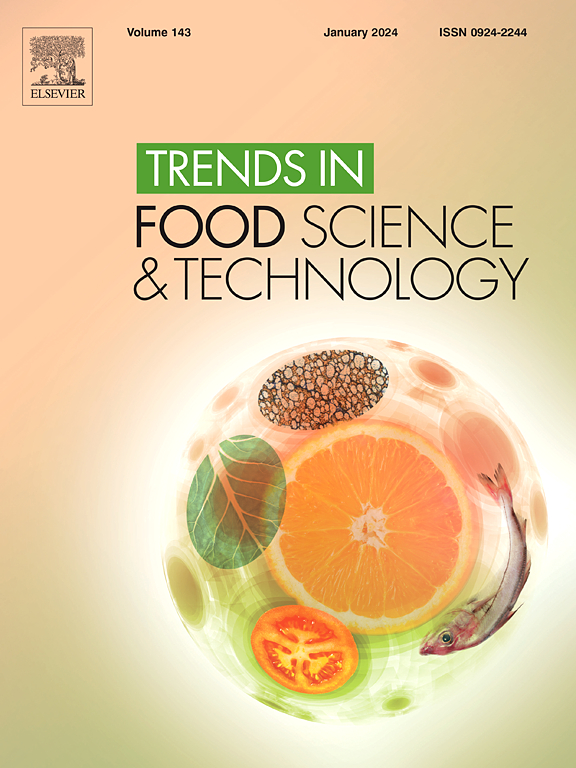A review of umami taste of Tea: Substances, perception mechanism, and physiological measurement prospects
IF 15.1
1区 农林科学
Q1 FOOD SCIENCE & TECHNOLOGY
引用次数: 0
Abstract
Background
Tea, celebrated for its delightful flavors and health benefits, is a globally cherished beverage. Umami taste is an essential contributor to its flavor profile and its perception mechanism is crucial for enhancing the taste quality of tea. The exploration of individual physiological and emotional responses to gustatory signals through physiological measurement techniques makes it possible to decode the mechanisms underlying umami perception.
Scope and approach
This article focuses on the umami taste of tea, providing a comprehensive review of the umami substances and the influencing factors. It discusses the umami perception mechanism from the perspectives of both umami-contributing and umami-enhancing aspects. Additionally, the paper explores the application prospects of physiological measurement technologies in decoding umami perception. This review aims to provide new analytical strategies for decoding umami and other taste perceptions.
Key findings and conclusions
Umami is one of the important sensory attributes contributing to the taste of tea products. The umami taste in tea is predominantly mediated by amino acids such as L-theanine, L-glutamic acid, and L-aspartic acid, with additional contributions from compounds like succinic acid and methylated catechins. The interaction of these umami compounds with the T1R1/T1R3 receptor complex involves a suite of molecular forces, including hydrogen bonding, hydrophobic interactions, van der Waals forces, and electrostatic interactions, which are essential for the stability and functionality of ligand-receptor binding. Neuroimaging and electrophysiological studies have further elucidated the neural basis of umami perception, providing a comprehensive understanding of the sensory input to cognitive processing associated with this taste modality.
茶叶鲜味的物质、感知机制及生理测量研究进展
茶以其宜人的风味和有益健康而闻名,是一种全球受欢迎的饮料。鲜味是茶叶风味的重要组成部分,其感知机制对提高茶叶的口感品质至关重要。通过生理测量技术探索个体对味觉信号的生理和情绪反应,使解码鲜味感知的机制成为可能。本文以茶的鲜味为研究对象,对茶的鲜味物质及其影响因素进行了综述。从增鲜和增鲜两个方面探讨了鲜味感知机制。此外,探讨了生理测量技术在鲜味感知解码中的应用前景。这篇综述旨在为解码鲜味和其他味觉感知提供新的分析策略。主要发现与结论sumami是影响茶品口感的重要感官属性之一。茶的鲜味主要是由l -茶氨酸、l -谷氨酸和l -天冬氨酸等氨基酸介导的,另外还有琥珀酸和甲基化儿茶素等化合物。这些鲜味化合物与T1R1/T1R3受体复合物的相互作用涉及一系列分子力,包括氢键、疏水相互作用、范德华力和静电相互作用,这对配体与受体结合的稳定性和功能至关重要。神经影像学和电生理学的研究进一步阐明了鲜味感知的神经基础,提供了对与这种味觉形态相关的认知加工的感官输入的全面理解。
本文章由计算机程序翻译,如有差异,请以英文原文为准。
求助全文
约1分钟内获得全文
求助全文
来源期刊

Trends in Food Science & Technology
工程技术-食品科技
CiteScore
32.50
自引率
2.60%
发文量
322
审稿时长
37 days
期刊介绍:
Trends in Food Science & Technology is a prestigious international journal that specializes in peer-reviewed articles covering the latest advancements in technology, food science, and human nutrition. It serves as a bridge between specialized primary journals and general trade magazines, providing readable and scientifically rigorous reviews and commentaries on current research developments and their potential applications in the food industry.
Unlike traditional journals, Trends in Food Science & Technology does not publish original research papers. Instead, it focuses on critical and comprehensive reviews to offer valuable insights for professionals in the field. By bringing together cutting-edge research and industry applications, this journal plays a vital role in disseminating knowledge and facilitating advancements in the food science and technology sector.
 求助内容:
求助内容: 应助结果提醒方式:
应助结果提醒方式:


